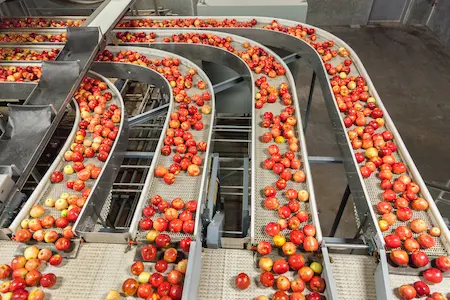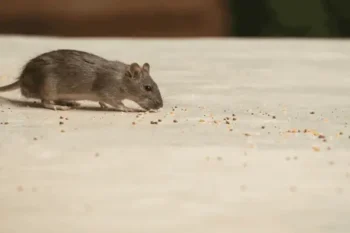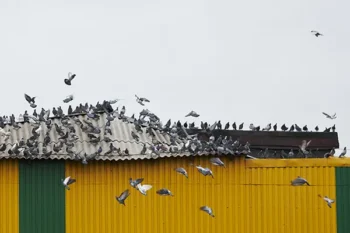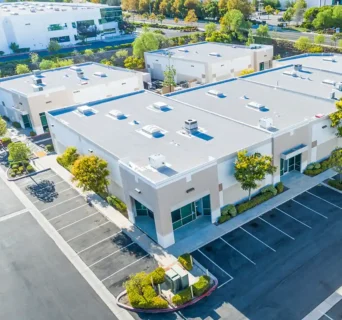
Commercial food and beverage facilities regularly monitor cleanliness, but bird contamination is an often overlooked risk.
Pest birds like pigeons and sparrows can cause disruptions and property damage. If you’ve noticed increased bird activity or nesting around your facility, contact Bug Out to learn more about professional bird control solutions and preventive measures.
Bird-related health risks
While some birds might appear harmless, many carry pathogens, fungal spores, and ectoparasites. These health risks can spread through their feathers, nests, or droppings. Birds have been associated with over 60 diseases, including histoplasmosis, encephalitis, Salmonella, toxoplasmosis, and West Nile virus.
Bird-related business risks
Within a food processing facility, all it takes is one bird to interfere with operations. If detected during a health or regulatory inspection, your company could face shutdowns or plant closures. In third-party audits, bird presence may also put business relationships at risk, and companies could face costly fines for health violations.
Unfortunately, managing a bird issue isn’t as simple as a quick fix. Many species are protected under federal, state, and local laws, so actions such as relocation or nest disturbance can result in legal and financial penalties. Seeking expert guidance before taking action helps ensure compliance with these regulations.
Common nuisance birds
Many bird species can pose challenges for food processing facilities, but some are more common to find than others.
Smaller birds often find their way indoors, such as:
- English house sparrows
- Common European starlings
- Swallows
Larger birds generally remain outdoors, but their presence can still damage rooftops and building structures, such as:
- Pigeons
- Seagulls
Why birds could be interested in your property
The surroundings of a food processing facility have a heavy influence on bird activity. Sites near water, landfills, or feed mills tend to draw larger bird populations and may require additional control measures.
Inside the facility, specific conditions and locations can make the space more appealing. Here are a few factors to take note of:
- Unsecured dumpsters and spilled products outdoors provide birds with an easy food source.
- Overhangs create sheltered spaces that serve as ideal nesting spots.
- Gaps in structures, such as those in corrugated siding, soffits, and weep holes, offer additional nesting opportunities.
- Worn dock door bumpers can trap food debris, attracting birds searching for nesting areas.
- Open windows and doors used for ventilation or accessibility give birds direct access indoors.
- Small gaps around doors can be enough for birds to walk inside.
Bird contamination risks
Birds can introduce contamination to food processing facilities by entering the building or congregating on rooftops.
Open doors offer easy access, and some bird species quickly learn to take advantage of these entry points. Once inside, they may fly through the facility or settle on rafters and other high surfaces, where droppings can fall onto production lines or stored products, increasing contamination risks.
Rooftops also attract birds, providing them with an elevated nesting point to locate food and shelter. HVAC systems, mechanical equipment, and air circulation units generate warmth, drawing birds to rest nearby. As these systems operate, they can pull in feathers and droppings, potentially spreading contaminants throughout the facility.
5 steps to deter birds from your business
Minimizing bird contamination is essential for any food processing facility. Partnering with a bird control specialist can help determine the most effective strategies based on your facility’s unique layout and environment.
Before a bird problem begins, consider taking these steps:
1. Keep doors and windows secured.
Birds often slip inside through open doors, typically left ajar for airflow or convenience. If ventilation is needed, installing screen doors provides a breezy environment while keeping birds out. Otherwise, strip doors create a flexible barrier that allows for human movement, but deters bird entry. Encouraging staff to close doors and windows when not actively in use further reduces the risk of unwanted bird access.
2. Consult professionals for future bird exclusion.
Installing netting beneath overhangs helps prevent birds from nesting or roosting in these protected areas. This approach also reduces bird activity near entry points, lowering the chance of them finding a way indoors.
3. Install perch deterrents in outdoor areas where birds tend to gather.
Options like spikes and electric tracks create unwelcoming surfaces without causing harm, encouraging birds to seek alternative roosting spots, and reducing their activity around the facility.
4. Close gaps at dock doors while trucks are stationed and inspect the building for any small openings.
Even minor gaps can provide entry for birds, so regular facility inspections should be a part of your to-do list. Pay close attention to delivery and pickup areas, as these are common spots where birds may gather or find their way inside.
5. Train staff on bird prevention strategies.
Employees may not always recognize the risks associated with birds. Regular training on potential issues and prevention methods can be the difference that prevents these problems. Emphasizing prompt cleanup, proper product storage, and effective waste management can help make the facility less appealing to birds. Assigning a team member to routinely check garbage and dumpster areas can further limit food sources and nesting materials.
Additional bird control tactics, such as hazing techniques or plant management, may also be useful. The best approach will depend on the facility’s design, the bird species present, and the surrounding environment.
Expert bird control to protect your business
Only a single bird is needed to cause large disruptions, so it’s best to act before an issue begins.
If you’ve noticed increased bird activity around your facility, or birds making their way inside, reach out to the specialists at Bug Out. Schedule a consultation at the first sign of trouble to maintain your company’s peaceful operations.





